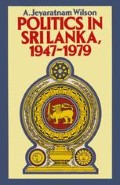Abstract
The mosaic that comprises Sri Lanka’s multiracial society* has since independence presented two pressing problems. The Sinhalese Buddhist majority (Low Country and Kandyan) have had specific economic grievances against the leading ethnic minority, the Ceylon and Indian Tamils, and the principal religious grouping the Roman Catholics in particular, as well as the Protestants (comprising Sinhalese, Tamils and Burghers). By 1978, the Sinhalese Buddhists had had the balance more than redressed on their behalf by successive governments in the post-1956 phase. This has especially been so in the employment, educational and commercial sectors.
Access this chapter
Tax calculation will be finalised at checkout
Purchases are for personal use only
Preview
Unable to display preview. Download preview PDF.
Notes
Central Bank of Ceylon, Survey of Ceylon’s Finances 1953 (Colombo 1954), and
Central Bank of Ceylon, Survey of Ceylon’s Consumer Finances 1973 (Colombo, 1974). See also Dr M. A. Fernando’s ‘Employment in the Rural Sector’, Ceylon Daily News, 30 May 1971, and The Educated Unemployed’, Ceylon Daily News, 2 June 1971.
From Minority Right Group, The Tamils of Sri Lanka (London, 1975), p. 13.
For detailed information, see D. L. Jayasuriya, ‘Developments in University Education: The Growth of the University of Ceylon (1942–1965)’, University of Ceylon Review, Vol. XXIII (April-October 1965) Nos 1 and 2, pp. 83–153.
See S. U. Kodikara, Indo-Ceylon Relations since Independence (Colombo, 1965), p. 111. Note, at its ninth annual sessions in April 1949, the C.I.C. condemned the provisions of the Ceylon Citizenship Act as ‘humiliating, discriminatory and anti-social’ and the qualifications required under the Indian and Pakistani Residents (Citizenship) Act as being ‘complex and involved, and beyond the capacity of workers with little or no education’ (ibid.). The latter assertion was, considering the education and literacy standards of the Indian population, factually correct.
See, for instance, the speeches of Sir P. Arunachalam, one of the foremost of the Ceylon Tamil leaders in the first quarter of the twentieth century, in S. W. R. D. Bandaranaike (ed.), The Hand Book of the Ceylon National Congress 1919–1928 (Colombo, 1928), pp. 70–97 and 118–43.
For a detailed account see Michael Banks, ‘Caste in Jaffna’, pp. 61–77 in E. R. Leach (ed.), Aspects of Caste in South India, Ceylon and North-West Pakistan, Vol. 2 (Cambridge, 1960).
Author information
Authors and Affiliations
Copyright information
© 1979 A. Jeyaratnam Wilson
About this chapter
Cite this chapter
Wilson, A.J. (1979). Problems in a Plural Society. In: Politics in Sri Lanka, 1947–1979. Palgrave Macmillan, London. https://doi.org/10.1007/978-1-349-17718-9_2
Download citation
DOI: https://doi.org/10.1007/978-1-349-17718-9_2
Publisher Name: Palgrave Macmillan, London
Print ISBN: 978-0-333-26208-5
Online ISBN: 978-1-349-17718-9
eBook Packages: Palgrave Political & Intern. Studies CollectionPolitical Science and International Studies (R0)

